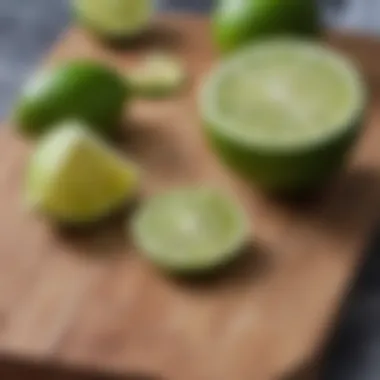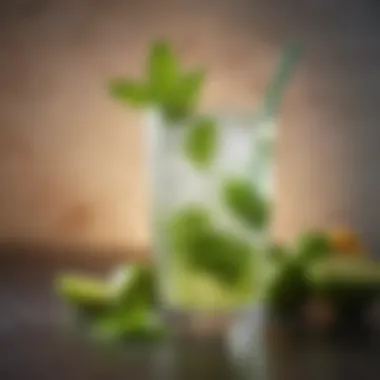How to Craft the Perfect Mojito Cocktail


Recipe Highlight
In this section, we focus on the Mojito. A classic Cuban cocktail that combines refreshing mint, zesty lime, and smooth rum. This drink offers a perfect balance of sweetness, acidity, and freshness, making it a quintessential summer beverage.
Essential Ingredients
- Fresh mint leaves
- Fresh lime
- White rum
- Granulated sugar
- Soda water
- Ice cubes
Estimated Time
- Preparation Time: 10 minutes
- Yields: 1 serving
Step-by-Step Instructions
To prepare a mojito, follow these clear and direct steps:
- Gather Ingredients: First, gather all your ingredients. Fresh mint and lime are essential for a genuine mojito.
- Muddle Mint and Sugar: In a sturdy glass, add 10-12 fresh mint leaves and two teaspoons of granulated sugar. Muddle gently to release the mint oils. Avoid pulverizing the leaves, as this can create bitterness.
- Add Lime Juice: Squeeze the juice from half a lime into the mixture. This adds acid and enhances the drink’s freshness.
- Incorporate Rum: Pour in 1.5 ounces of white rum. This is the heart of the cocktail and will provide richness.
- Add Ice: Fill the glass with ice cubes.
- Top with Soda Water: Finally, top the mixture with soda water. This adds a refreshing fizz.
- Garnish: Add a sprig of mint and a lime wedge for decoration. This enhances aesthetic appeal.
Cooking Techniques
Muddling is crucial. This technique helps release essential oils from the mint without destroying the leaves. Proper muddling will create an elegant flavor profile.
Insider Advice
- Avoid too much sugar; this can overpower the mojito’s freshness.
- Use freshly squeezed lime juice; bottled versions are often less flavorful.
- Be mindful of the ice. Overfilled glasses may dilute the drink too quickly.
Variations and Substitutions
There are countless ways to customize a mojito:
- Fruit Variations: Try adding fresh fruit such as strawberries, raspberries, or cucumber to infuse different flavors.
- Herbal Twists: Substitute mint with basil for a different aromatic experience.
- Sugar Alternatives: For healthier options, use stevia or agave syrup to minimize refined sugar.
Pair your mojito with light appetizers like shrimp ceviche or tortilla chips to complement the cocktail’s flavors.
Time-Saving Cooking Tips
To streamline your mojito preparation:
- Prep Ingredients: Pre-squeeze lime juice or have mint leaves ready before mixing.
- Use a Muddler: If muddling multiple servings, use a dedicated muddler to speed up the process.
- Batch Mixing: Consider preparing a larger pitcher for gatherings, adjusting ingredient quantities accordingly.
Nutritional Information
A standard mojito contains approximately:
- Calories: 200 per serving
- Sugar: 11 grams
- Fiber: 0 grams
This cocktail is low in fat and provides some vitamin C from the lime. While mojitos are not considered a health food, enjoy them moderately within a balanced diet.
Given their refreshing nature, mojitos suit a variety of diets, although adjust sweeteners as needed for dietary restrictions.
Prologue to the Mojito
The mojito is not just a cocktail; it is a refreshing embodiment of cultural history and culinary craftsmanship. This section will delve into the essential aspects of the mojito, highlighting its significance in the realm of mixology. Understanding the mojito means appreciating the interplay of flavors and traditions that have shaped this drink over centuries.
Origin and History
The mojito traces its roots back to 16th century Cuba, making it a drink steeped in history. Originally, it is believed to have been concocted with a primitive form of rum known as "aguardiente," mixed with mint, lime, and sugar. These ingredients were thought to have medicinal qualities and were popular among sailors and locals alike.
The drink evolved as rum production improved and became widely available. By the early 20th century, the mojito made its way into Havana’s bars, capturing the attention of influential writers such as Ernest Hemingway. His famous haunt, the La Bodeguita del Medio, is often credited for popularizing the drink globally. This rich history gives the mojito a distinct heritage that many drinkers might not fully appreciate.
Cultural Significance
The mojito holds a special place not only as a beloved cocktail but also as a symbol of Cuban identity and social enjoyment. In Cuba, it transcends the mere act of drinking; it is a tradition often enjoyed during gatherings, celebrations, and even leisurely afternoons.
The act of making a mojito reflects a communal experience. Friends gather, sharing stories while crafting this drink together, aligning with the values of hospitality and friendship that are intrinsic to Cuban culture. The mojito invites people to pause, reflect, and enjoy the moment.


"Drinking a mojito is not just about taste; it represents a connection to community, history, and culture, making every sip significant."
Essential Ingredients
Understanding the essential ingredients of a mojito cocktail is crucial for achieving an authentic flavor and delightful experience. Each ingredient contributes a unique aspect to the drink, and the balance among them plays a significant role. Choosing fresh, high-quality ingredients enhances the overall taste and elevates the cocktail-making process. Consideration of flavors, freshness, and alternatives is key to mastering the art of mojito making.
Fresh Mint Leaves
Fresh mint leaves are the soul of a mojito. They provide a refreshing aroma and a crisp taste that defines the cocktail. Selecting good quality mint is easy; look for bright green leaves without any wilting. When muddled, mint releases essential oils, which infuse the drink with intensity. Be gentle while muddling, as crushing the leaves too harshly can release bitterness.
Incorporating mint in the right amounts ensures the cocktail remains not overly medicinal. A few sprigs in a traditional mojito is generally adequate. Some also prefer to use a mix of spearmint and peppermint to create a deeper flavor complexity.
White Rum
White rum is another vital component. It acts as the base spirit, offering warmth without overpowering the other ingredients. The quality of rum can affect the cocktail significantly. Aged rums or dark rums may introduce unwanted flavors that conflict with the refreshing nature typical of a mojito. When selecting white rum, look for brands known for their clean and smooth profiles. This spirit should be mixed, not sipped, preserving the essence of the mojito experience.
Sugar
The choice of sugar impacts sweetness and texture. Traditionally, granulated sugar is used; however, simple syrup is becoming a popular alternative for ease of mixing. Using too much sugar can overwhelm the drink and mask the mint and lime flavors. The right balance is essential; ensure the sweetness complements the tartness of the lime juice. Consider experimenting with demarara sugar or agave syrup for unique flavor variations.
Lime Juice
Fresh lime juice provides the necessary acidity and tartness. It’s important to extract juice from fresh limes rather than using pre-packaged versions, which often contain preservatives. The acidity from lime balances against the sweetness, resulting in a well-rounded flavor profile. Aim for about half a lime per mojito, adjusting according to your personal preference.
Club Soda
Club soda adds fizz and lightness to the mojito. It’s vital to use a good quality soda, as some brands can have excessive sodium or off-flavors. Choosing sparkling water is another option, adding a different texture while retaining the refreshing quality of the drink. Just ensure it is chilled before mixing in, as temperature affects the drink's presentation and flavor.
Ice
Ice is more than just a cooling agent. It helps dilute the drink slowly, balancing the bold flavors gradually. Using crushed ice can enhance the overall experience of a mojito as it allows for more surface area and quicker chilling. When preparing the drink, fill the glass generously with ice to maintain the ideal temperature and consistency. Avoid large cubes that may not melt adequately, potentially leading to an overly strong or unevenly chilled mojito.
Tools Required
Making a mojito requires a few essential tools that enhance the cocktail preparation process. Each tool plays a specific role in ensuring the ingredients are combined effectively, leading to a refreshing and enjoyable drink. Understanding each tool’s function allows for better mastery over mixing techniques and presentation.
Muddler
The muddler is a simple yet critical tool in mojito preparation. It is used to crush the mint leaves gently. This process releases the mint's essential oils, imparting the herb's fresh essence into the drink. A good muddler typically has a sturdy handle and a flat end, ideal for this purpose. Care should be taken not to pulverize the mint leaves to the point where they become a paste. Instead, aim for a gentle press to extract the flavors without shredding the leaves.
Cocktail Shaker
A cocktail shaker is essential when mixing drinks, particularly for a mojito. This tool allows for effective mixing of the liquefied ingredients, contributing to a well-blended cocktail. A shaker can be a two-piece style or a three-piece style with a built-in strainer. When shaking the mojito, you help to dissolve the sugar and integrate the flavors of mint, lime, and rum smoothly. This results in a cohesive drink that balances the sweet and tart notes beautifully.
Jigger
Precision is important in cocktail preparation, and a jigger ensures accuracy in measuring ingredients. This tool allows for easy measuring of liquid components, such as rum and lime juice, ensuring consistent flavor with each preparation. A standard jigger typically has two sides, with different measurements indicated. Using a jigger can help avoid the common mistake of over-pouring, which could result in an unbalanced mojito.
Glassware
The choice of glass for serving a mojito is not merely an aesthetic one. Typically, a highball glass is used, as it allows ample room for the ice, mint leaves, and lime. The height of the glass also facilitates the mixing of the ingredients when serving. Using appropriate glassware enhances the presentation and adds to the overall drinking experience. The right glass allows the drinker to appreciate the visual appeal while enjoying the intricate flavors of the cocktail.
Preparation Steps
Preparation steps form the backbone of crafting a mojito cocktail. Each step contributes uniquely to the final flavor and character of the drink. Therefore, understanding the significance of these steps can enhance both the preparation experience and the quality of the beverage.
With five key actions—muddling, mixing, and final touches—you can make a mojito that is refreshing and well-balanced. Skipping or hurrying through any of these steps can lead to a cocktail that lacks depth.
Every aspect deserves careful attention, allowing the fresh ingredients to shine. Completing these steps properly will ensure your mojito has the right blend of flavors and a pleasing texture.
Muddling the Mint
Muddling the mint is a critical first step. This process involves gently crushing fresh mint leaves with a muddler or the back of a spoon. The goal is to release essential oils without tearing the leaves into shreds. Strong minty flavor comes from these oils.
Remember to muddle lightly to avoid bitterness from the leaves. This act also helps to combine mint with sugar, setting the stage for the rest of the drink.


Adding Sugar and Lime Juice
After muddling, the next step is to add sugar and lime juice. The sugar acts as a sweetener to balance the tartness of the lime. This combination creates a harmonious base for the mojito.
Ideally, the sugar should be granulated as it dissolves easily when stirred with the lime juice. It is essential to mix these two ingredients well so that sugar does not settle at the bottom of the glass. The acidity of the lime juice also helps in breaking down the sugar granules more effectively.
Incorporating Rum
Incorporating white rum is where the cocktail begins to take shape. The rum adds body and intensity to the drink. Pouring in the rum after combining mint, sugar, and lime juice ensures that the flavors are well-integrated.
A typical mojito uses a standard measure of white rum, but the quantity can be adjusted according to personal preference. It is important to stir again gently, so the rum and other ingredients mix uniformly.
Mixing with Club Soda
Once the rum is incorporated, the next step is adding club soda. This effervescent addition lightens the cocktail and enhances the refreshing quality. Pour the club soda carefully into the glass to avoid disturbing the muddled mint and other ingredients too much.
The ratio of club soda can vary, but generally, it should eclipse the rum to maintain a pleasant balance. Stir lightly to combine while being cautious not to muffle the carbonation, which adds a delightful fizz.
Final Touches
Final touches elevate the drink from ordinary to exceptional. This involves garnishing with fresh mint sprigs and perhaps a lime wheel for visual appeal.
Garnishing not only makes the mojito look inviting, but it also adds an aromatic dimension to the drinking experience.
Additionally, consider adjusting the sweetness with extra sugar or adding more lime juice to taste, according to personal preference.
In summary, paying attention to each of these preparation steps will produce a mojito that is both pleasing to the palate and visually delightful. Employing fresh, high-quality ingredients and taking the time to execute each step enhances the overall drinking experience.
Tips for a Perfect Mojito
A well-made mojito relies on several key factors. Understanding these elements is essential for anyone seeking to elevate their cocktail experience. Attention to detail in ingredient selection, balancing flavors, and presentation can transform a simple drink into a memorable one. This section will elucidate important points that can help create a perfect mojito.
Choosing Quality Ingredients
Quality ingredients are the backbone of a superb mojito. The freshness of each component will directly influence the drink's flavor profile. Fresh mint leaves are crucial; they provide the unmistakable minty essence that complements other ingredients. When you select mint, opt for vibrant, green leaves that are free from browning or wilting.
The choice of rum is also vital. Use a good quality white rum, such as Bacardi Superior or Havana Club, to impart a clean flavor. While it may be tempting to save on cheaper alternatives, they often result in a less enjoyable finish. Ensure that the lime juice is fresh; bottled alternatives can lack the brightness needed for a true mojito.
Additionally, the sugar used should enhance the taste rather than overpower it. Raw sugar or cane sugar typically offers a more natural sweetness compared to white sugar. Consider experimenting with more artisanal options, which may provide different flavor notes.
Balancing Sweetness and Tartness
A perfect mojito strikes a delicate balance between sweetness and tartness. When you muddle the mint leaves with sugar and lime juice, be cautious about the amount of sugar added. Too much sweetness will mask the refreshing tartness of the lime. Conversely, too little may result in a drink that feels unbalanced.
To achieve this harmony, begin with a modest amount of sugar and add lime juice gradually. Taste as you go to determine if adjustments are necessary. Typically, a ratio of roughly 2 teaspoons of sugar to half a lime’s worth of juice works well, but personal preferences will vary.
If you find the drink is leaning too heavily toward sweetness, a splash of additional lime juice can enhance the tartness without disrupting the overall mix. Conversely, if it’s too tart, a sprinkle of sugar can elevate the sweetness. It is a trial-and-error process that rewards patience with satisfying results.
Garnishing Techniques
Presentation matters when serving a mojito. A visually appealing drink enhances the overall experience. The garnish can elevate the cocktail from ordinary to extraordinary. Common garnishing techniques include using a sprig of fresh mint or a lime wheel. When placing the mint on top, gently slap it to release its aromatic oils before using it as a garnish.
Another technique involves adding a few berries, such as raspberries or blackberries, for a splash of color and additional flavor. These small modifications can give your mojito a unique character, making it stand out at gatherings.
For glassware, choose a highball or Collins glass. This not only complements the aesthetics but also offers a practical approach for both stirring and serving the cocktail. To finish, consider adding a straw that enhances both practicality and appeal.
Remember, the little details matter. A well-garnished drink reflects the effort put into making it.
The proper combination of ingredients, attention to balance, and innovative garnishing will ensure your mojito is a crowd-pleaser. Each sip should resonate with freshness and simplicity, allowing all elements to shine through.
Mojito Variations
Mojito variations are a splendid way to explore the boundaries of flavor while preserving the quintessential essence of the original cocktail. These alternatives enhance the traditional recipe, making it adaptable to various palates and seasons. The variations not only keep the spirit of creativity alive in cocktail making, but they also cater to different preferences, inviting everyone to enjoy this refreshing drink in their own way.
Fruit-Infused Mojitos


Fruit-infused mojitos are an excellent option for those who appreciate fruity flavors. By adding fresh fruits, the mojito transcends its original taste. Popular fruits like strawberries, raspberries, and pineapple can be muddled with mint to create an exciting twist.
- Using Fresh Ingredients: Fresh fruits bring vibrant taste and color, making the drink visually appealing.
- Adjusting Sweetness: Fruits also introduce varying levels of sweetness, allowing you to balance the sugar content according to your preference.
- Seasonal Selections: Depending on the season, you might choose citrus fruits in summer or apples and pears in fall to match the changing palette.
To make a fruit-infused mojito, simply muddle a handful of fruit with mint before proceeding with the traditional steps of the cocktail. The result is a refreshing beverage that complements the natural flavors of the original mojito.
Herbal Mojitos
Herbal mojitos offer an intriguing alternative by incorporating different herbs beyond mint. For instance, basil, rosemary, or even cilantro can be used to elevate the drink's flavor profile. This is particularly appealing for fans of garden-fresh ingredients.
- Exploring Aromatic Layers: Each herb brings its unique aroma and complexity. Basil adds a sweet yet peppery twist while rosemary adds an earthy undertone.
- Enhancing Freshness: The essence of herbs enhances the freshness of the drink, creating a refreshing experience that is ideal for hot afternoons.
- Garnishing: Using sprigs of the chosen herb as garnish can provide a visually pleasing finish while reinforcing the flavor.
When creating herbal mojitos, muddle the selected herbs alongside the mint. This method allows all the flavors to meld, resulting in a unique take on the classic cocktail.
Frozen Mojitos
Frozen mojitos are perfect for hot summer days when a cold drink is required. These icy delights bring a new texture and chill to the classic recipe, making them refreshing and enjoyable.
- Blending for Consistency: Crush ice and blend it with the ingredients. This process creates a slushy texture that is ideal for sipping on a warm day.
- Flavor Infusion: When blending, consider adding fresh fruit or flavored syrups to enhance sweetness and depth.
- Serving Ideas: Rim the glass with sugar or salt before pouring the frozen mixture for added flavor and appeal.
Making frozen mojitos involves blending lime juice, sugar, mint leaves, and ice together until smooth. Serve immediately in a chilled glass to ensure an enjoyable experience.
Incorporating variations into your mojito repertoire amplifies the drink's versatility and allows for personal expression in cocktail making. Explore freely!
Serving and Enjoyment
Serving a mojito correctly enhances not just the drink's appeal but also its overall experience. The way a cocktail is presented can significantly influence enjoyment. Attention to detail in the serving process can elevate a simple drink into an impressive refreshment.
Presentation Ideas
A well-served mojito can be visually striking. Begin with a clean glass; a highball glass is a classic choice due to its tall shape. Fill the glass with fresh crushed ice, leaving some space at the top to maintain the drink's refreshing nature and to accommodate garnishes.
When pouring the mojito mixture over the ice, consider the following presentation techniques:
- Color Contrast: The vibrant green of mint contrasts beautifully with the clear rum and club soda. This creates a visually appealing drink.
- Garnishing: Place a sprig of fresh mint on top. This not only adds a pop of color but also enhances the aroma as the drinker takes a sip.
- Lime Slices: Adding lime slices to the rim of the glass can create a fresh look. It also serves as a reminder of the drink's tart flavor.
For an extra touch, consider using decorative straws or stirrers. It's a minor detail that can add to the experience without overshadowing the drink itself.
Pairing Food with Mojitos
Choosing the right food to accompany mojitos can elevate a meal or gathering. The refreshing and zesty flavors of a mojito complement various dishes:
- Seafood: Light, fresh dishes such as ceviche or grilled shrimp work well with mojitos. The cocktail's acidity cuts through the richness of the seafood.
- Mexican Cuisine: Tacos al pastor or fresh guacamole create a delightful pairing, as the mojito balances the spices and enhances the overall meal experience.
- Salads: A crisp salad, especially with citrus elements, pairs nicely with a mojito. The drink reflects the freshness of the ingredients while providing a palate cleanser between bites.
It is often beneficial to consider the mojito's ingredients when choosing food. The acidity from lime and the sweetness from sugar play crucial roles in harmonizing flavors. Thus, avoiding overly heavy dishes is advisable; instead, opt for lighter, fresher options to complement the mojito's crisp nature.
"The key to a great drink experience lies in how you serve and enjoy it together with food."
By considering presentation and pairing options carefully, the mojito can become more than just a drink; it can be a centerpiece of enjoyment during gatherings.
End
The conclusion of this comprehensive guide serves to solidify the knowledge gained about crafting the perfect mojito cocktail. Reiterating the significance of methodical preparation, quality ingredients, and effective mixing is essential. Each element contributes to the overall flavor profile of the mojito, influencing not only the taste but also the enjoyment of the drink.
A well-prepared mojito can elevate one’s cocktail experience. It reflects the artistry involved in mixology and allows for personalization based on individual preferences.
Recap of Key Points
In summary, the key aspects covered in the article include:
- Essential Ingredients: Fresh mint leaves, white rum, sugar, lime juice, club soda, and ice are crucial for an authentic mojito.
- Preparation Steps: Proper muddling, combining ingredients, and the final mixing process are fundamental steps for achieving freshness.
- Tips for Perfection: Quality ingredients and a balanced flavor profile can set an exceptional mojito apart from average versions.
- Mojito Variations: Exploring different ingredients can provide new dimensions to the traditional recipe.
Understanding these components prepares anyone to create a refreshing and genuine mojito.
Encouraging Experimentation
Experimentation with mojitos is both encouraged and valuable. Each component of a mojito has its own possibilities. Changing the type of sugar from granulated to simple syrup or infusing fresh fruit can lead to unique flavors. Trying different herbs, such as basil or cilantro, can also add unexpected richness to the experience.
The essence of mixology lies in discovering one’s taste preferences. Note personal adjustments and adapt the recipe based on feedback from friends and family. This exploration not only hones skills but creates memorable experiences around shared beverages.
Great cocktails come from both adherence to tradition and the creativity to innovate. Let your mojito-making journey be a blend of both.







